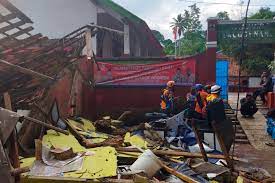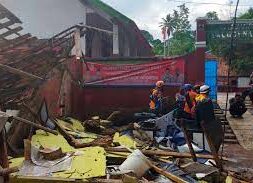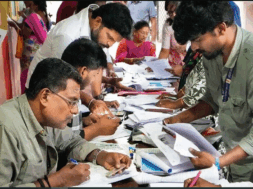
56 Killed, 700 Injured in Earthquake in Java
Manas Dasgupta
NEW DELHI, Nov 21: A strong but shallow 5.6-magnitude earthquake killed at least 56 and injured about 700 others as it toppled buildings and collapsed walls on Indonesia’s densely populated main island of Java on Monday.
Hundreds of people rushed into the streets, some covered in blood and white debris, as the earthquake triggered landslides. Doctors treated patients outdoors after the quake — felt as far away as the capital Jakarta — left hospitals without power for several hours, officials said.
Emergency workers were treating the injured on stretchers outside main hospitals, on terraces, and in parking lots. Many included children, some of whom were given oxygen masks, IV lines and were being resuscitated.
Residents, some crying with children in their arms, fled damaged homes after the quake shook the Cianjur region in West Java province in late afternoon, at a depth of 10 kilometres. It also caused panic in the greater Jakarta area, where high-rises swayed and some were evacuated.
Rescue teams and civilians in Cianjur were looking for others who may have been buried in the debris of collapsed brick houses. The quake was powerful enough to bring down walls, chunks of concrete and roof tiles, some of which landed inside bedrooms. “You can see it yourself, some got their heads, feet sewn outdoors. Some got stressed and started crying,” West Java governor Ridwan Kamil said. He added that power had been partially restored by the evening, without specifying if through a generator or connection to a power grid.
The afternoon quake was centred in the Cianjur region of West Java, according to the United States Geological Survey, with local authorities saying 56 people had been killed and over 700 wounded. “Because there are still a lot of people trapped on the scene, we assume injuries and fatalities will increase over time,” said Kamil as ambulance sirens blared throughout his press conference.
The majority of deaths were counted in one hospital, head of Cianjur’s local administration Herman Suherman said earlier, with most of the victims killed in the ruins of collapsed buildings. He told local media the town’s Sayang hospital had no power after the quake, leaving doctors unable to immediately operate on victims.
More health workers were urgently needed due to the overwhelming number of patients, he added. Locals rushed victims to the hospital on pickup trucks and motorbikes. They were placed in front of the facility as residents spread a tarpaulin on the road for the bodies.
Kamil, the governor, said multiple landslides had cut off road access to some areas and bulldozers were being used to open them up. “The quake felt so strong, my colleagues and I decided to get out of our office on the ninth floor using the emergency stairs,” said some employees in South Jakarta.
Herman Suherman, the head of Cianjur regency, said the death toll reached 56 as of Monday evening. Around 700 were injured, said National Disaster Mitigation Agency chief Suharyanto. Several landslides were reported around Cianjur. Among the dozens of buildings that were damaged was an Islamic boarding school, a hospital and other public facilities, the agency said.
Information was still being collected about the extent of casualties and damage. Some victims and survivors were being taken to the government hospital in Cianjur, where emergency tents were erected and workers treated the injured. Indonesia’s Meteorology, Climatology, and Geophysical Agency recorded at least 25 aftershocks.
Relatives of victims congregated at the hospital while at another facility, Cimacan hospital, green tents were erected outside for makeshift treatment. “We are currently handling people who are in an emergency state in this hospital. The ambulances keep on coming from the villages to the hospital,” Suherman said. “There are many families in villages that have not been evacuated,” Indonesia’s disaster chief Suharyanto, said information was “still developing”.
Earthquakes are not rare across the sprawling archipelago nation, but it is uncommon for them to be felt in Jakarta. The country of more than 270 million people is frequently struck by earthquakes, volcanic eruptions and tsunamis because of its location on the “Ring of Fire,” an arc of volcanoes and fault lines in the Pacific Basin.
In February, a magnitude 6.2 earthquake killed at least 25 people and injured more than 460 in West Sumatra province. In January 2021, a magnitude 6.2 earthquake killed more than 100 people and injured nearly 6,500 in West Sulawesi province. A powerful Indian Ocean quake and tsunami in 2004 killed nearly 230,000 people in a dozen countries, most of them in Indonesia.
French President Emmanuel Macron was the first world leader to offer his condolences. “Indonesia was hit this morning by an earthquake of destructive and deadly force. Thoughts for all the victims,” he wrote. Indonesian President Joko Widodo is yet to respond to the quake.
Indonesia’s meteorological agency warned residents near the epicentre to watch out for more tremors. Indonesia’s meteorological agency said it recorded 25 aftershocks in Cianjur after the quake. They ranged from magnitudes 1.8 to 4 on the Richter scale. But there were no reports of casualties or major damage in Jakarta.














